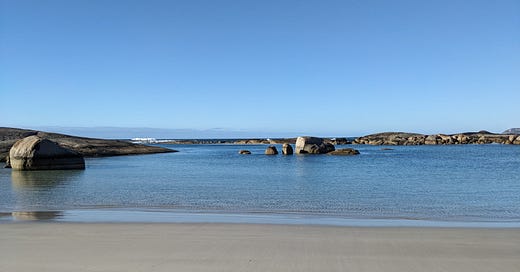The beach was already crowded when we arrived at 6.30am. We weren’t the only ones to decide an early-morning swim was the best way to start a new year.
I walked. The beach wide and firm. Gulls in the air. Wind in my face when I turned and walked back. I swam then, the water clear. Not at all cold. Dozens of people already in the water. Usually when we swim early there is just a handful of regulars; often there is no-one else in sight. I admit to preferring that.
I swam across the embayment towards the rocks, conscious as I backstroked of not crashing into anyone. I turned and swam back. Someone ahead of me was pointing out a wobbegong to a friend. “It’s just over here, near the rock,” she said. “It’s been hanging around here for at least a month.” They swam and I heard snippets of their conversation as they surfaced and talked, then put their faces into the water and looked. I was tempted to swim over and see for myself. I’ve never seen a wobbegong. I mentioned this to a friend recently. “You’ve never seen a wobbegong?!” he said, incredulous. He says he sees them all the time, but then someone else said he is the master at spotting the well camouflaged creatures, “Except the one that bit you!” the friend’s friend said. “You were bitten by a wobbegong?” I asked. “Well, he did tread on it,” the friend’s friend said. My friend shrugged. “It wasn’t that bad.”
Wobbegongs are a type of shark and are also called carpet sharks. They have symmetrical, blotchy patterns and often lie on the ocean floor, barely discernible amongst the seaweed. They are sharks but are not considered dangerous to humans. Attacks are rare and only occur when swimmers, divers or snorkellers get too close. I guess treading on one is too close. Still, if I’m going to come across a shark while swimming, I’d like it to be a wobbegong. But today was not the day I was going to see one. Perhaps tomorrow I’ll snorkel over to where the people were looking at the one this morning, and see if I can see it.
After this morning’s swim we joined other regular swimmers for a picnic breakfast on the beach. Then home to milk the goat and get on with the day; to get on with the year. Yesterday was 2024; today is 2025. Strange concept when I stop to think about it.
People have been counting years for millenia; for longer than the two and a bit millenia indicated by today’s date. There is evidence of people marking time way back in pre-history, in the Neolithic period, around 3000 years BC. It makes sense. People seem to like counting things, and it’s useful to know how much longer winter is going to last or when it might rain again, when the days will get longer or shorter. Early calendars tended to focus on solar and lunar passages, as they still do. Months are loosely about the moon’s cycles and years relate to the earth’s laps of the sun. The Julian Calendar, on which our months are based, dates back to the times of Julius Caesar. Caesar proclaimed the Julian calendar on 1 January 45BC. Of course, he didn’t say it was 45BC at the time, because the year numbering of BC years was added later. In Roman times, years were counted for the emporer’s rule. The AD and BC counting came later. Which means, curiously, not only was 45BC not called that at the time, but back in the year 10AD that wasn’t called that either. Nor was 200AD. Our counting system as such didn’t start until the sixth century after Christ when a monk, Dionysius Exiguus, set about determining a consistent way of counting years. He didn’t like the old Roman way of counting years (he had a thing about Roman emperors persecuting Christians), so he counted back to when he reckoned Christ was born and called that 1AD. He did this in the year he called 532AD, and we’ve been counting along from there ever since. The annual calendar had a bit of tweaking in 1582, when it was worked out that the years and the sun were going to get out of sync because the solar year is 365.2422 days long but the average calendar year under the Julian calendar was 365.2425 days. Splitting hairs maybe, but these things accumulate over time. So in 1582 Pope Gregory XIII decreed the Gregorian calendar, which did some fine tuning to what would and wouldn’t be leap years to line up our counting with the earth’s orbit around the sun. These days, most, but not absolutely all, of the world uses the Gregorian calendar and counts from AD1.
So we get to 2025. Which for me begins with a swim and a resolve to spend more time writing and to see a wobbegong. I hope it’s a good year for you.
Happy New Year.
Jill




